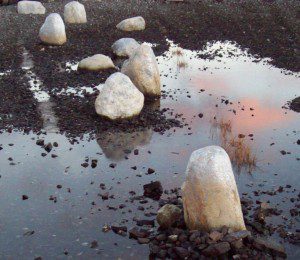
In a recent New York Times’ opinion piece, Against Invulnerability, Todd May takes a stand against philosophies that advocate that we develop an invulnerable stance in the face of the vicissitudes of this life. “Invulnerabilism,” he writes,”recommends that we secrete a distance between ourselves and the world so that ultimately it cannot touch us.”
And he includes Buddhism as one of these secreting approaches.
Like most rich religious traditions, Buddhism is a category in which many different teachings and approaches to life are included. So a critic might find grounds to wrap us up with the Stoics, for example, by selectively reading the original teachings of the Buddha.
The Zen way, though, is emphatically not a way of cultivating the delusion of invulnerability – quite the contrary, the Zen way is about radical vulnerability. Let me cite a couple cases from one old master, Ch’ien–feng, to make the point.
Ch’ien–feng was a direct successor of Dongshan Liangjie (Japanese, Tozan Ryokai), a bright light in the Cao-dong/Soto lineage. Indeed, Dongshan/Tozan put the “dong” and the “to” in Cao-dong and Soto. But little is known of Ch’ien–feng, although he appears a few times in the koan literature.
And according to Morten Schlutter in How Zen Became Zen (p.93), in the oldest records, Ch’ien–feng is one of the teachers through whom the later Cao-dong/Soto lineage flowed. But because he was not well known, the 12th Century reconstructionists of the Cao-dong/Soto lineage selected Ch’ien–feng out and the more well-known Yunju in. Be that as it may….
I’m rather fond of Ch’ien–feng and his straight-edged way of making the radical-vulnerability point. For example: A monk once asked Ch’ien–feng, “How does one escape the three realms?”
The three realms are either past, present and future or the spheres of desire, form, and formlessness (click here for more detail). To reframe the monk’s question, then, in light of May’s piece, “How does one escape the world and become invulnerable?”
Ch’ien–feng said, “Call the temple director and have him chase this monk out of here!”
Apparently, Ch’ien–feng was not feeling the monk’s other-worldly question and didn’t even take time to write him a referral. One can only imagine the reception Mr. May might have received from Ch’ien–feng.
Here’s another, more complex working of the issue (for a full rendering, see Waddell’s The Essential Teaching of Zen Master Hakuin, p. 19, Ferguson’s Zen’s Chinese Heritage, p. 219, or Cleary’s Book of Serenity, p. 47):
Priest Ch’ien–feng addressed his assembly: “The dharmakaya has three kinds of sickness and two kinds of light. Can any of you clarify that?”
The dharmakaya is the truth-body of the buddha, the fundamental, absolute truth, usually grouped with the sambogakya (the bliss-body of the buddha) and the nirmanakaya (the form-body of the buddha). Click here for more detail.
Ch’ien–feng says something radical here – the truth-body of the buddha has three kinds of sicknesses.
From a standard buddhalogical perspective, you might think that the form-body of the buddha might have sicknesses – it is a form body, after all, like this body. Or you might think that even the form-body of the buddha would be a perfected, not-sick body. In either case, the absolute, beyond duality, dharmakaya, truth body, would be free from sickness and light.
So Ch’ien–feng utterance is biting in much the same way as the “No” that Zhaozhou declares the dog’s buddha nature to be.
“The dharmakaya (aka, truth body) has three kinds of sickness and two kinds of light.”
Wow. Ch’ien-feng makes the world shake and shudder.
By the way, the three kinds of sicknesses vary by commentary but are along the lines of thinking that there’s something to get from practice, thinking that you’ve got it, and thinking that you’re free of getting and not getting. Or if you prefer beast-of-burden metaphors, then the three sicknesses are searching for a donkey while riding on a donkey; after getting on the donkey, being unwilling to get off; and getting off the donkey and dancing freely. Any position, in other words is a position of sickness.
The two kinds of light vary even more by commentary. Being a simple person, I like to think of them as the light of samadhi and the light of realization.
To reiterate, Ch’ien–feng asserts that the highest truth is sickness and light. No invulnerable position is advocated here.
Then Ch’ien-feng asks, “Can any of you clarify that?”
Yün-men came forward and said, “Why doesn’t the fellow inside the hermitage know what’s going on outside?”
There is always some blindness. “When one side is illumined,” said Dogen, “the other side is dark.”
This too is the truth-body buddha.
Leave it to Yün-men to show it so clearly.
Ch’ien–feng roared with laughter.
Ch’ien–feng laughs the laugh of the liberated in this very vulnerable body.











